As the 1960s marched on, Walt Disney finally began to tire out, beset by work with animated and live action films, television, and theme parks—both the known, open park in California, by now open for ten years, and the still top secret park in central Florida, slowly grabbing up land and legal rights. But the mixed critical response to the Sword in the Stone—a film he had little involvement in—worried him, and he decided to take a more active role in the next animated film. This included agreeing with the suggestion of story artist Bill Peet that Disney’s next film should focus on one of the studio’s clear strengths—funny animals—and also once again taking an direct role in story development as the artists started working on The Jungle Book.
This active role unfortunately led to the departure of Bill Peet from Disney, since the two had different visions for the film. Peet wanted to stay more or less faithful to the text; Walt Disney, wanting something more amusing, urged the animators to ignore Rudyard Kipling whenever possible. This was not totally without precedent or foundation: Disney had, after all, greatly condensed and changed the source material for Pinocchio, introduced a dragon to Sleeping Beauty, and eliminated most of the original Wind of the Willows, to name only some of the bigger changes.
But The Jungle Book was to depart even further from the source material, with only the first ten minutes of the film having that much to do with the original Mowgli stories. About the only remaining elements: Mowgli is raised by wolves; Shere Khan the Tiger wants to eat him; and half the characters have the same names. Otherwise, plot elements, characters, motivations and even the end of the Mowgli stories are completely changed. Not just because Walt Disney urged animators to ignore Kipling, but because for The Jungle Book, animators were trying something new: basing their cartoon characters not on the source material, but the voice actors.
Take, for instance, Baloo, in the original text a wise, respected elderly mentor who patiently drills Mowgli in the laws of the jungle and who looks like a bear; in the film, a wisecracking, easily distracted slacker with a tendency to break into song who advises Mowgli to chill out and just focus on the bare necessities, and who rather looks like singer/comedian Phil Harris.
Animators loved the result, so much that they not only increased the role of Baloo in the film, but also started wondering if they could bring in a few other well-known singers. Like, say, the Beatles. Or maybe Louis Prima. The Beatles declined, although four vultures in the final film do sport suspiciously Beatles like haircuts and speak with British accents. But Louis Prima, then at the peak of musical career number four or five, depending upon how you count them, and needing a distraction from major life events at the time, did agree to jump on.
And that, everyone, is why a film about a boy and a bunch of animals in India stops for a big American swing dance number dead smack in the middle of the film, led by King Louie the orangutan cheerfully crooning, “I’m the king of the swingers, whoa!”
I love it.
Having gone so far, animators did not hesitate to make several other drastic changes: Kaa the snake and the elephants were turned into comedy figures; the wolves were almost entirely eliminated; and —presumably in hopes of replicating the ongoing success of Dumbo—an adorable little baby elephant was added.
So it’s not exactly from the book.
(It’s not at all from the book.)
On the other hand, it has Phil Harris and Louis Prima, as a dancing bear and a swinging orangutan.
Let us not be too critical.
It was also a major success, so successful that two elements became models for later Disney films: the sidekick voiced by a celebrity comedian (Charles Lane, The Aristocats; Jim Jordan, The Rescuers; Cheech Marin, Oliver and Company; Buddy Hackett, The Little Mermaid; Robin Williams and Gilbert Gottfried, Aladdin; Danny De Vito, Hercules; Eddie Murphy, Mulan), and characters who were basically just caricatures of their voice actors (for instance, Miss Bianca, for all intents and purposes Eva Gabor, in The Rescuers; Ratigan, a barely disguised Vincent Price in The Great Mouse Detective; Cogsworth, who even as a clock looks quite a lot like David Ogden Stiers in Beauty and the Beast; and a not even slightly disguised Paul Shaffer, playing a divine keyboard in Hercules.) The technique was not always a success, creativity or financially, and the studio was to crack down on this for some films, but it was so ubiquitous that it’s often hard to remember now that this was not a feature of most of the films produced under Walt Disney’s supervision.
Not that all of the celebrity voices in The Jungle Book were that successful. Academy Award winner George Sanders, for instance, delivered an oddly muted performance in gentle, malevolent tones for Shere Khan, with the result that Shere Khan is one of the weakest points of the film. This isn’t entirely the fault of Sanders: the plot has Shere Khan easily tricked by Kaa the snake, who in turn is so inept that he can’t manage to eat ten year old Mowgli, which doesn’t exactly make Shere Khan seem like that much of a threat. The tiger’s later attack is somewhat more competent, but he’s brought down by Baloo—the lazy comedian bear—and some very laid back vultures; if his target weren’t a ten year old boy, I’d say that Shere Khan is fairly toothless. It perhaps didn’t help that Sanders, like Prima, was going through some difficult personal issues while voicing the role, which may have robbed his voicing of some passion.
Fortunately, this is not a movie all that focused on the villain. Oh, yes, to a certain extent Shere Khan drives part of the plot of the film—his return is the reason Mowgli is forced away from his barely seen wolf family and more or less escorted back to the human village by Bagheera (given a very pompous British voicing by Sebastian Cabot). And he’s the other half of the one of the film’s most visually hilarious scenes with Kaa. But he’s absent for much of the film, which is—mostly—about trying to find a home when not otherwise distracted by flashy musical numbers.
Mowgli almost finds that home, several times: first with the wolves, then with Baloo the bear, then almost if not exactly with the elephants (they think his nose is too small), somewhat with the monkeys and King Louie (who want to learn how to make fire), sort of with Kaa (who mostly wants to eat him, but who unexpectedly ends up saving his life), and finally with the vultures. It seems clear that, without Shere Khan, Mowgli could easily live in the forest. He makes friends easily; he’s clever, if naïve, and very willing to adapt to any circumstances that would accept him.
And yet, even once Shere Khan is removed, Mowgli does not remain in the jungle. Because, sigh, he sees a girl, singing as she fetches water.
Something like this more or less happened in the Kipling text, of course, where Mowgli did try to live with humans, and did eventually marry, even if it is somewhat surprising to see the film return to the text after 45 minutes of forgetting it. And Mowgli’s choice is not entirely unreasonable. Mowgli is, after all, human, the girl is pretty, she’s singing about the home she will later have, and Mowgli has been hunting for a home throughout the film—
No. It just feels wrong.
Part of the problem is that this scene happens at the end of a film where Mowgli has been visibly upset at the idea of leaving the jungle, and visibly happy to stay there, and happens right after Mowgli has earned the right to stay there: with the help of friends, he has driven off a tiger, and those same friends have offered him not just one, but two homes. To have this end with Mowgli trotting off to a third home —a home that he hasn’t earned (unless surviving the film counts), and where he not only has no friends, but doesn’t even know anyone, does not feel quite as happy as the film thinks it should feel.
Not, of course, that a ten year old should have to earn a home. But by the same token, I’m not sure a ten year old should have to leave a home, either. Yes, like many Disney films, The Jungle Book is about growing up, and leaving a childhood home —but most of the others who made this journey either wanted to leave that home, or were older, or both. Mowgli fits neither category.
The scene presents another issue as well, that of work versus, well, the bare necessities. That song —”The Bare Necessities” —is one of the two musical highlights of the film, and arguably its most memorable moment —unless you’re the sort of person who prefers swinging monkeys. In it, Baloo cheerfully assures Mowgli that he can forget about his worries and his strife, and the bare necessities will come to him. If this does, admittedly, include eating ants, and if it sounds slightly hypocritical, sung, as it is, by a very wealthy singer, and performed in a film funded by a corporation that was, outside this film, telling small children that they needed not just the bare necessities, but also Mickey Mouse toys and trips to Disneyland, and if, as a grownup, I find myself slightly skeptical that life in the jungle is really all that simple (I mean, tigers! They’re even in the film!), I can’t help but think it also sounds very tempting. And Mowgli agrees: the film shows him singing and dancing —and happy.
In contrast, the girl’s song includes several references to all the work she will have to do in her future home.
So, life in the jungle with friends, singing, dancing, and barely any work as Mowgli appreciates the bare necessities, or trudging water back and forth to the village between doing other back breaking labor? Which song do you remember?
I’m being a bit unfair here, of course, because what Disney is describing is all part of growing up. And this is hardly the first Disney film to have a similar message —Pinocchio, too, gave its protagonist a glimpse of a life of complete leisure and fun, before ending with something else. But Pinocchio illustrated the dangers of that life. The Jungle Book has one danger —a tiger —and once that tiger is eliminated, offers no good reason why ten year old Mowgli can’t stay with his friends in the jungle. Except, a girl, singing about work.
Beyond that, I still can’t shake the feeling that it’s both too hard and too easy. Too hard, because Mowgli leaves a family and life he wanted; too easy, because Mowgli has, after all, spent his childhood with wolves. This is, I admit, colored by my reading of the book, which acknowledged the reality and difficulty of that situation: the film Mowgli, after all, easily adjusts to and mimics bears, elephants, and orangutans. I can’t think of a good reason why the film Mowgli couldn’t easily adjust to and mimic humans as well. But I still find myself itching at the ending.
And then there’s the animation. The good parts first: the backgrounds are lovely, beautifully rendered paintings, the best work Disney had done since Sleeping Beauty, and before that, Peter Pan. Also, someone freed up some money for some effects work, and much of the water sequences look great, as do the character designs, and almost all of the orangutan swing number dance sequence —quite possibly one reason why some of that scenes were simply flipped over and reused in Robin Hood a few years later. And now, the bad part: once again, the budget cuts show, with bits of recycled animation, thick black xerography lines, still showing pencil marks, and other small flaws that become far more visible when you watch this film on a large screen. The film also demonstrates just why animating tigers, with their stripes, can be so difficult: if you watch carefully, Shere Khan’s stripes change throughout the film, sometimes within the same scene. (After this, Disney was to avoid tigers, animating only two of them —Tigger and Jasmine’s pet tiger in Aladdin —until the advent of computer animation.)
Audiences, however, loved the film, turning The Jungle Book into one of Disney’s all time most successful films: a top box office performer in 1967 that continued to do well in subsequent releases, and currently listed among Amazon.com’s top 200 best selling films. “The Bare Necessities” became one of Disney’s two all time most popular songs until the arrival of the 1990s films. Some of the characters later appeared in Disney’s Talespins, The film spawned at least two later sequels and a live action remake; another live action remake is coming soon.
Alas, Walt Disney did not live to see the film’s success, dying of lung cancer shortly before The Jungle Book was completed. It was the last Disney animated film to be created under his direct influence. Robbed of their guiding light, and also, most of their funding, the Disney animation studios went into a steep decline for several years, when, that was, Disney animators could even produce a film at all. In most years, they did not.
A signal to skip the next two films:
Although The Aristocats, the last film greenlit by Walt Disney, and the first to be made without his direct supervision, is not usually credited as the first Disney original (a title usually if somewhat questionably given to either Dinosaur or Lilo and Stitch), the story it is supposedly based on never appeared in print. Tom McGowan and Tom Rowe, credited with the story, wrote the screenplay, leading some Disney scholars to credit this as the first animated Disney film not based on a previous source. The film did decently if not great at the box office, and Disney continues to sell Aristocats related merchandise today, more than justifying the original investment.
Robin Hood, of course, is not a Disney original, but I have two reasons for skipping it: one, I kinda feel that I already said everything that I could say about Robin Hood here. Two, inasmuch as the film is based on anything at all, it’s based on previous Robin Hood films —particularly the Errol Flynn and Douglas Fairbanks versions —not texts.
Ok, I lied. Three reasons. Robin Hood is just not very good. It has one redeeming factor: the “Not in Nottingham” sequence —but otherwise, it’s a diffuse, meandering film that never quite manages to come together. This is largely because for budget reasons, much of it was copied and traced from earlier films, used animation initially intended for and then discarded from the Winnie the Pooh shorts, or directly reused animation from previous films (if Little John looks remarkably like Baloo in several sequences, that’s because he is Baloo, just with slightly different coloring. One dance sequence with Little John, for instance, is the dance sequence with Baloo and King Louie, flipped over and recolored.). And that’s not even counting the animation bits recycled within the film itself. With those constraints, it’s not surprising that the film could never really coalesce around a plot. It may not be quite the worst Disney film ever —as we’ll see, it has some stiff competition —but it’s just not good.
Which brings us to Winnie the Pooh, another character who was to have a profound effect on the Disney corporation —if not entirely because of his animated role.
Mari Ness lives in central Florida










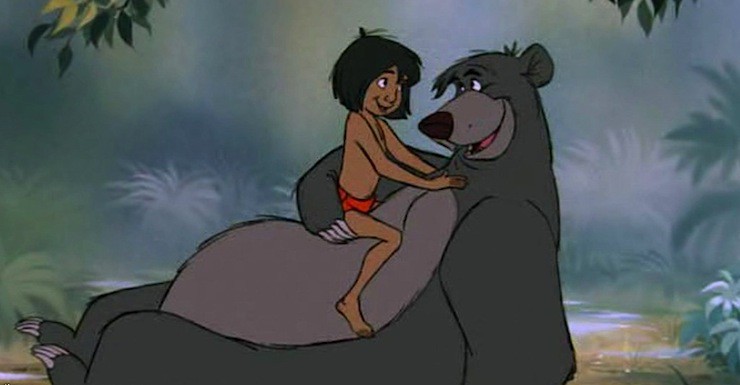
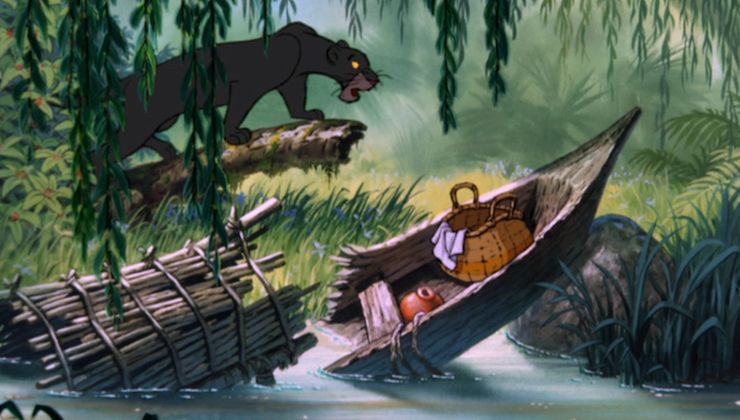

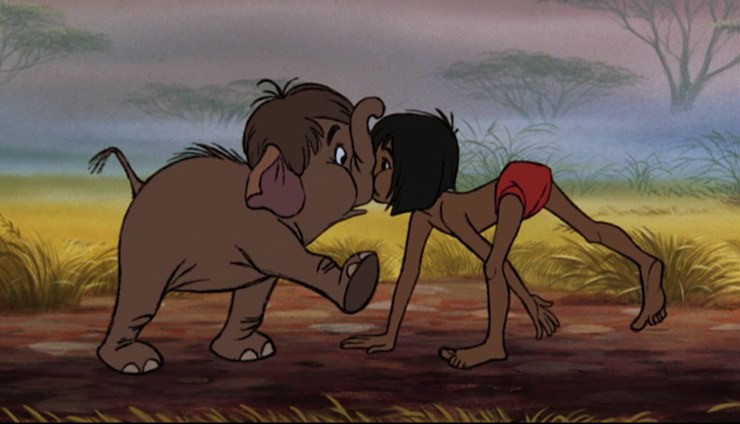
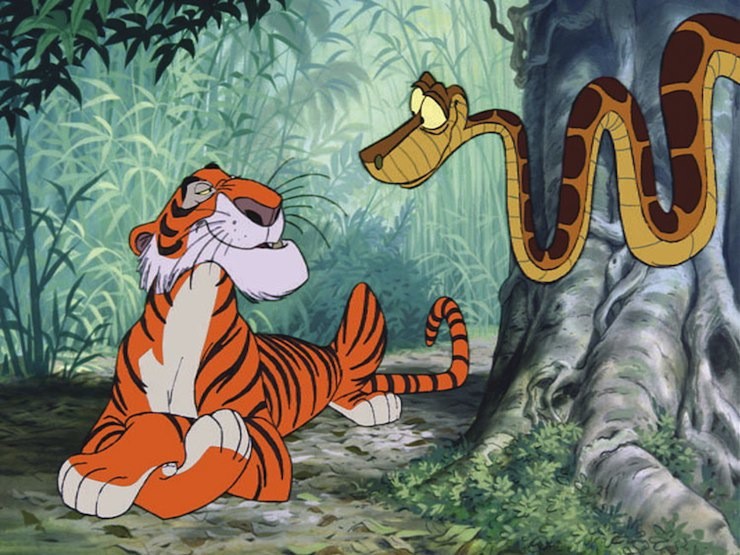
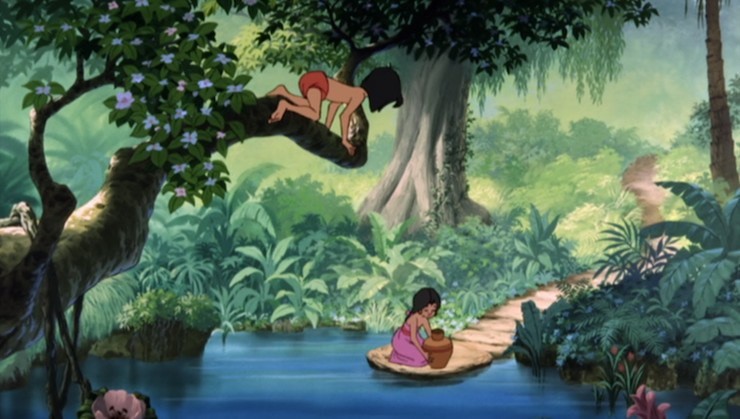
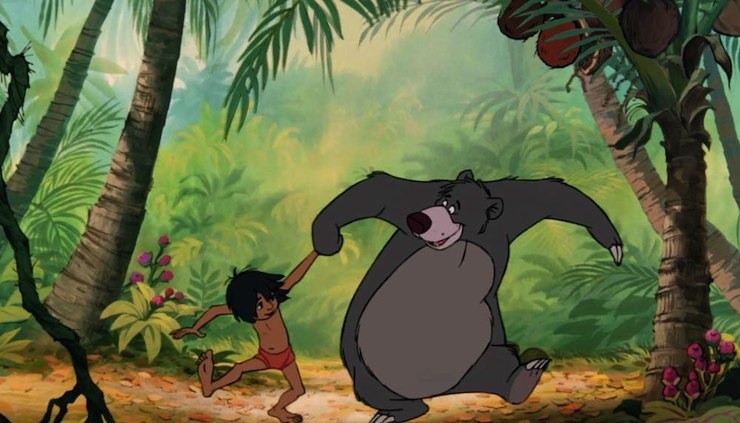
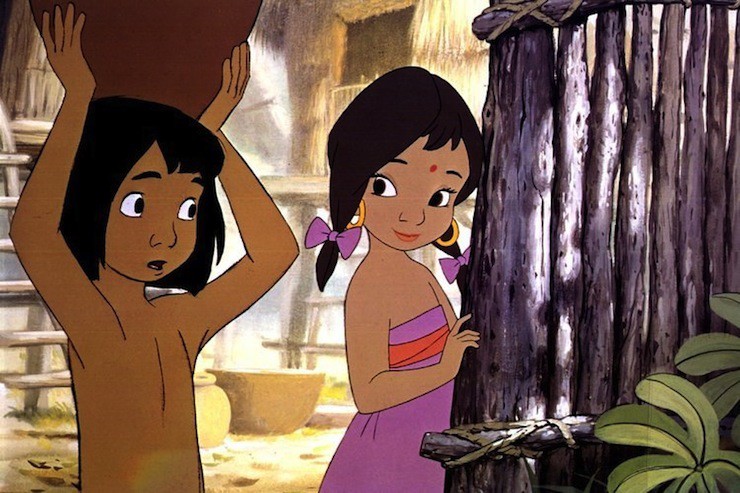
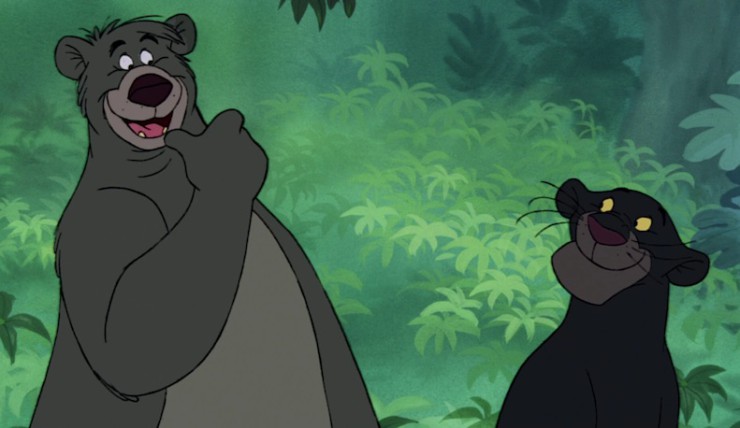
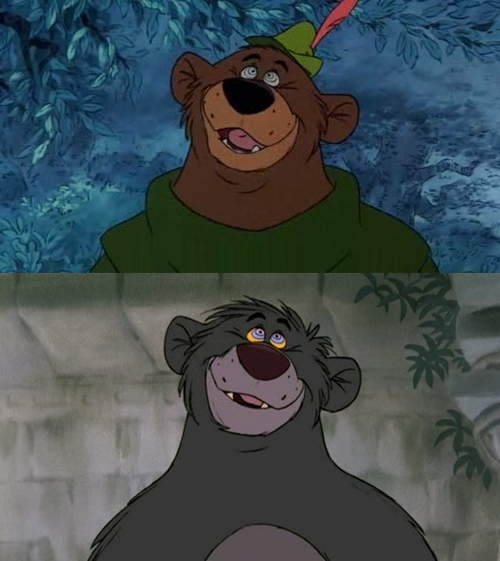
I don’t think Mowgli will have too hard a time adapting to the village. As you said, he makes friends easily. And who’s to say he can’t visit his friends in the jungle from time to time? And if the kid can get several animals on his side against a tiger, he’s a benefit to the village as well. Maybe this was touched on in the sequel. I don’t know. I never saw it. Didn’t want anything to ruin my image of this wonderful film.
Anyway, this is an excellent review, Mari. Keep up the great work!
It made sense to me that he would resist leaving for a new place but would become curious once he actually saw other human beings.
I am fully willing to admit that I am powerfully influenced by nostalgia and repeated viewings at an early and impressionable age, but I love The Sword in the Stone and Disney’s Robin Hood. I’ll even support the fact that story-wise The Sword in the Stone is a complete mess, but this is some of the first negative commentary I’ve run into about Robin Hood. I always kind of thought that it was generally well-liked.
I suppose it is easy to lose sight of the quality of our cinematic comfort food. My college roommates and I would put both of them on regularly to play in the background while we worked on papers and such.
I am really enjoying this read-watch though and this was another great one. Thanks!
I haven’t seen this movie since I was a kid, but I remember thinking that the girl was the first human Mowgli had ever seen and he suddenly realized there were other people who looked like him (walked like him, talked like him…sorry, that song’s in my head now), and he belonged with them in a way that he would never truly belong with the animals. Of course, I was probably 10, so I might have failed to grasp the subtleties of making a family vs being born into a family etc. Plus, I was 10, so happy romantic ending!
I also loved Robin Hood as a kid, though I saw it within the last few years, and yeah, it’s not very good. I realized I still have all the songs memorized, though! I think we had the soundtrack — probably on vinyl to be played on my Fisher-Price record player. I would kind of like to watch Jungle Book and Robin Hood back to back now, just to see the reused scenes.
This is a great review series, Mari! I look forward to it every Thursday!
“’Tis he, O girl! O, discover thy beauty, thy comeliness shew (him),
So that thy loveliness he may possess—(O), in no wise be bashful,
Ravish the soul of him, as soon as his eye on thee falleth,
He, forsooth, will approach thee, and thou—O, loosen thy mantle,
So that he clasp thee, and (then) with the wiles of a woman shalt ply him;
(Wherefore) his animals, bred in his desert, will (straightway) deny him,
(Since) to his breast he hath held thee.”
Seduction of Enkidu, a 4000+ year old trope. Of Course he’s going to get a (literally) funny look on his face and follow her into the village.
I agree that it’s not what a “real” wild boy would do, but if many historical boys claimed to be wild may have actually be autistic boys, a non-hostile approach from a female might indeed work.
— — — — —
I’m surprised to learn that Disney approached the Beatles. I took the narrative of the movie to be hostile to the trend of long hair on men. From the elephant getting a crew cut to the disreputability of the vultures, and the monkeys, no love lost on long hair or modern music in the text in my reading. Baloo is presented as being irresponsible for enjoying such things, and they overcome the monkeys because they’re lucky (plot armor) and because the monkeys were presented as incompetent beatniks.
— — — — —
In my opinion, the incompetence and irresponsibility of Baloo and the Vultures is set up to be overcome when they save Mowgli from Shere Khan. They are sticking their necks out to do the right thing and thus redeeming their previous behavior. So they triumph because of righteousness, not because the Tiger is weak. The movie is just very unrealistic, and is best savored, rather than dissected.
Have to issue the internet guy correction, just because the show was truly that good at times. TaleSPIN!
I saw the stage version performed in Boston. They added additional Indian influenced numbers and the wolves had a larger role and there was more of the Kipling story included as well. If you get the chance go and see it.
I have to disagree about Sanders. His understated silky voice was very good at conveying quiet menace.
Hah, we were on vacation this past week at my in laws’ and somebody put this movie on for the kids, so I’ve recently re-watched it! And I was thinking about how it was great timing for the read watch :D
This is another one of those ‘watched it as an adult’ movies but I do like it. Not on my top 10, but it’s got some cute, silly, funny moments, and the songs are fun.
We have to take a second to talk about the Sherman Brothers, whom I adore. It’s funny you mention the song by the girl as being less memorable, because that is absolutely the song I always think about when I think about this movie, and probably one of my favorites. I’m not talking about the lyrics – in fact, they’re probably kind of sexist if you squint at them hard enough (or then again, maybe not. I’m not knocking anybody who looks forward to running their own home). But OMG, the melody. I love the melodies of the Sherman Brothers and something about it is incredibly haunting and addicting to me. A few years back I watched a really interesting documentary on them and it was interesting how their two personalities contributed. (I’m pretty sure there is a DTV sequel where the girl gets more characterization and I think they DON’T end up together in the end)
This maybe came up in another one of the movies, but I don’t get the impression we are supposed to root for Mowgli to stay with Baloo. It’s kind of like ‘Hakuna Matata’ – yeah, it’s nice for awhile, but that’s not what growing up is about. I suppose there is something to say about family, and if we choose it, or if we can fight ‘who we are’, and if Mowgli is better off or not. But as others and you have noted – he’s adaptable, likeable and clever.
A few other points:
1)I really enjoyed Sanders’ performance
2)Regarding the comments, the vultures came off as positive to me because, as you said, they are loyal and stick up for their friend (and were quick to welcome him into their group to start with). I never got the impression they were considered otherwise lazy or incompetent.
And, since we don’t get to talk about them later – I really like both the Aristocats and Robin Hood. Robin Hood I remember as a child and I always loved it (although I’ve watched it as an adult and can agree there are some dull parts). But I loved your story too :)
Have to second everyone who enjoyed George Sanders as Shere Khan, I think he really sells it. It makes me curious what direction the new film will go in, since Idris Elba has a very different sort of voice. Personally I would have cast Giancarlo Esposito as Shere Khan and Idris Elba as Akela, but of course Elba is the bigger name.